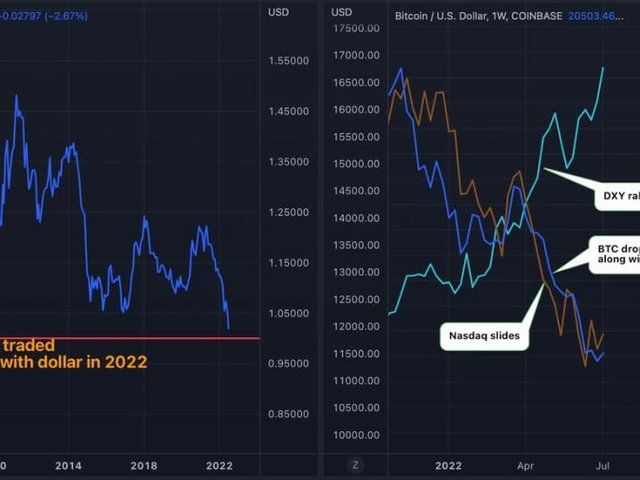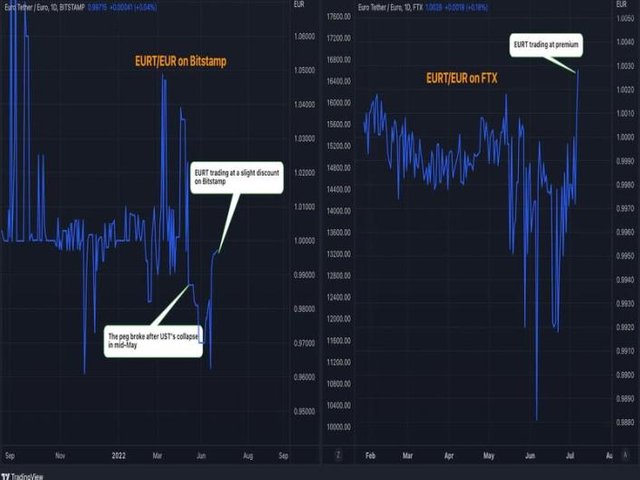Euro’s Fall Toward $1 Parity: What It Means for Crypto
The euro's drop to the $1 level for the first time in 20 years - so-called parity with the US dollar - caught the attention of some crypto traders about the impact of the exchange rate on the US dollar. with the pricing of cryptocurrencies and stablecoins linked to the common European currency.
Thanks to the emergence in recent years of stablecoins pegged to government-issued currencies other than the US dollar, the vast foreign exchange sector has gradually penetrated the digital asset market.
And some observers suggest that the euro's latest drop could put downward pressure on the bitcoin (BTC) market and affect demand for euro-pegged stablecoins.
“Currency turmoil (such as what the euro and others are currently experiencing) often ends in favor of the US Dollar as forex market participants see it as a low-risk 'currency' best '. The interest rate trajectory differs between the US and the EU,” said Noelle Acheson, head of market intelligence at crypto exchange Genesis Global Trading. “This could negatively impact the dollar price of bitcoin, which over the past two years has been negatively correlated with the dollar index.” (Genesis is owned by Digital Currency Group, the parent company of CoinDesk.)
The euro has fallen 10% against the dollar this year, an important move for the major fiat currency pair. The exchange rate was last seen near 1.02, which is 200 pips below the 1.00 par.
The drop seems to stem from the European Central Bank (ECB) lagging behind the Federal Reserve in tightening monetary policy despite rising inflation, the threat of a widespread energy crisis in the European Union and recession fears.
Gregory Klumov, CEO of stablecoin platform Stasis, said in an email: “There are clear risks of recession and reduction in excess dollar-denominated margin in the stock market today. Stasis is the issuer of euro stasis (EURS), the world's second-largest euro-pegged stablecoin by market value. “When this happens, all borrowers buy back dollars to repay the loans they took out to improve yields and increase exposure to risky assets,” Klumov said. "Thus, when the property is sold and the funding is returned, the dollar will appreciate. The euro is no exception in this case."
Money market experts are confident that the ECB will continue to lag, allowing EUR/USD to slide below 1.00. Taking off from a record negative interest rate of -0.5% is easier said than done for the ECB, as recent hawkish expectations have seen Italian bond yields fall relative to their German counterparts, making increased risk of fragmentation. Fragmentation essentially means that when the central bank raises interest rates, the impact of the tightening is not felt equally on the euro area. Financial markets are driven by sentiment, so when a major national currency like the Euro is trampled and pushed towards or below a critical level, investors tend to steer clear of risky assets, fiat currencies and established safe havens like US dollars and authorities. obligations. As a result, a EUR/USD drop to or below 1.00 could boost widespread demand for the greenback, pushing bitcoin and other risk assets lower.
While bitcoin cultists have long hailed the cryptocurrency as a safe-haven asset, the digital currency has historically moved in tandem with tech stocks and in the opposite direction. dollar index (DXY). For example, DXY, which tracks the value of the greenback against major currencies, is up nearly 12% this year. Meanwhile, bitcoin and Wall Street's tech-heavy Nasdaq index fell 55% and 27%, respectively. Not everything can't be changed. But it's mostly modeling.

Focus on euro-pegged stablecoins
Europe-pegged stablecoins could lose their shine.
Stablecoins are tokens that are tracked by a blockchain and aim to consistently match the purchasing power of a fiat currency, such as the dollar or the euro. The stablecoin issuer commits that the user or owner of the stablecoin can redeem the investment at any time at a 1-to-1 exchange rate.
This structure exposes users to currency risk. For example, let's say a trader named Bob bought a euro-backed stablecoin EURT a month ago. Theoretically, Bob could exchange EURT for one EUR at any time. However, the EUR/USD rate fell
.2% from 1.065 to 1.02 in four weeks. So if Bob were to buy back EURT today, the buyback would result in a loss of
.2% in dollars, assuming he doesn't make an additional profit by lending assets on protocols to decentralized borrowing and borrowing.
As a result, holders of euro-pegged stablecoins can choose to buy them back, based on the common currency's bearish outlook.
“Overall, 1.0 is an important psychological level,” Dessislava Aubert, senior research analyst at Paris-based Kaiko, told CoinDesk in an email. “If it breaks, it will most likely spur some short-term forex volatility, spill over into other asset classes, including cryptocurrencies, and trigger a sell-off in assets backed by Bitcoin. Euro."
Laurent Kssis, managing director and Europe head of crypto exchange-traded fund firm Hashdex, said the euro-pegged stablecoin market can be tested for strength and under pressure. force.
According to CEO Gregory Klumov, CEO of Stasis, investors are abandoning euro-denominated and euro-backed assets. "In the event that capital outflows from euro assets, euro stocks and euro bonds play out, one can observe euro stocks falling more than US indices over the past few weeks. And of course, the stable euro is falling deeper than Klumov says.
“As the dollar remains the #1 standard for determining prices in the crypto space, even for European users, the euro stablecoin is considered a risky asset (although the EUR is not one) random risky assets). “There are cash flows from euro vaults at the moment, and investors would change everything to dollars in such a situation,” Klumov added.
One question is whether the potential buyback and volatility of Euro-pegged stablecoins will have a contagion effect like Terra on the broader crypto market. The answer is probably no, because the market for euro-pegged stablecoins is quite small.
The Euro-pegged stablecoin market is worth $
0 million at press time. This is just 0.29% of the $151 billion pegged stablecoin market value, according to data tracked by CoinGecko. Broadly speaking, the cryptocurrency has a market capitalization of $950 billion.
The largest euro-pegged stablecoin at press time is the euro-backed bond, or EURT, with a market value of $210 million. Euro stasis, or EURS, the second largest euro stablecoin, has a market cap of $126 million. Terra's Algorithmic Co-stable UST had a market cap of $18 billion before crashing in mid-May, dragging the crypto market lower and causing volatility in the broad stablecoin market. than.
“Euro-backed stablecoins still represent such a small portion of the overall market that any buybacks that the current euro weakness may cause will have no effect,” Acheson said. have a significant impact on overall market capitalization,” Acheson said. At the time of writing, EURT is trading at a slight discount, just below the 1 euro lockout on Bitstamp, after falling to 0.96 euros on June 20. The price broke down following the collapse of the UST. in mid-May. Meanwhile, the Euro is trading at a slight premium on crypto exchange FTX.

Zero-sum game and ECB rate hikes
The money market is a zero-sum game. When we say that the euro is likely to lose ground against the dollar, it also means that the dollar is expected to rise and there is an incentive to hold dollar-denominated assets.
So while a fall in EUR/USD could hurt the appeal of euro-pegged stables, it could boost demand for fiat-pegged stables. dollar. With the Fed aggressively raising interest rates to curb inflation, traders have a good reason to hold dollar-pegged stablecoins.
Additionally, the ECB is expected to abandon its negative interest rate policy this year, which is likely to bode well for the euro and common currency-backed assets. Circle, the issuer of the second-largest dollar-pegged USDC stablecoin, recently launched a new euro-backed stablecoin called EUROC, presumably in the hopes that the ECB rate hike will translate to demand of assets backed by the euro.
Rate negotiators expect the ECB to raise benchmark borrowing costs by 1
0 basis points (1.
percentage points) by the end of the year. The central bank's benchmark interest rate is currently -0.5%.
“Rising interest rates will benefit profitable products, like stablecoins,” said Bill Cannon, head of exchange-traded product portfolio management at Valkyrie. “Similar to a traditional FX strategy, utility depends on product usage and we understand that opportunities are currently limited to euro-denominated stablecoin products. But like everything else in crypto, that can change quickly. "
Your post was upvoted and resteemed on @crypto.defrag
Thanks